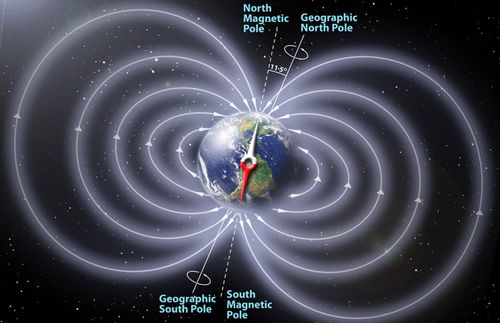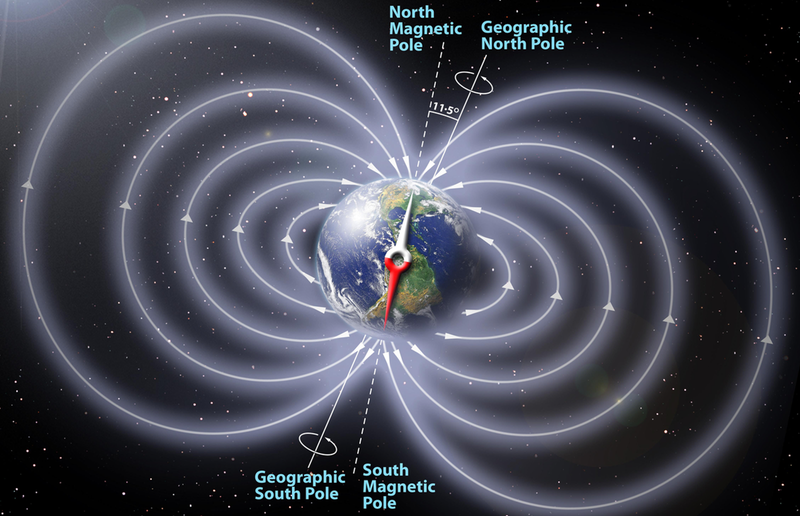Electric Power from the Earth’s Magnetic Field
It might seem that classical electromagnetic theory would hold few surprises, but two researchers argue that one aspect of received wisdom is wrong. They show theoretically that a device, sitting passively on the Earth’s surface, can generate an electric current through its interaction with the Earth’s magnetic field. The power from the proposed device would be measured in nanowatts, but might, in principle, be scaled up.
A century-old experiment showed that if any electromagnet with cylindrical symmetry (the symmetry of a bar magnet) rotates about its long axis, its magnetic field does not rotate [1]. There is a component of the Earth’s magnetic field that is symmetric around the rotation axis (which is not aligned with the magnetic poles), so according to this old principle, the axisymmetric component does not rotate. Any stationary object on the Earth’s surface sweeps through this component of the field, which is constant at any given latitude.
Another basic result from electromagnetism says that no electric current will develop within a conducting object moving through a uniform magnetic field. Charges within the material experience a sideways force that could, in principle, produce current. But the displacements of the electrons and atomic nuclei quickly set up a static electric field that opposes the magnetic force. Equilibrium between the electric and magnetic forces is quickly established, so there is no net motion of charge following the small, initial rearrangement.
This principle seems to squelch any idea that a stationary device on the Earth’s surface, moving at constant velocity through the nonrotating part of the Earth’s field, could generate any electric power. But Chris Chyba of Princeton University and Kevin Hand of the Jet Propulsion Laboratory in Pasadena, California, saw a way forward.
To produce current in the conductor, they needed to create a magnetic force on the electrons that could not be completely canceled by the electric force. In what they call a loophole to the traditional impossibility argument, the theorists show that there are configurations of magnetic fields that can’t be electrically cancelled; however, these configurations require special conditions.
The researchers show that such a magnetic field configuration is possible in a conducting cylindrical shell made of a material with unusual magnetic properties. First they point out that (as others have shown) the magnetic field inside such a shell placed on the Earth’s surface—say, oriented vertically at the equator—is significantly smaller than the field outside. As this object sweeps through the planet’s field, it is continually confronting the Earth’s uniform field and distorting it into some nonuniform configuration where the field is suppressed in the internal space. If the shell material’s magnetic properties prevent the incoming field from distorting rapidly, then the field will never reach the configuration it would have at rest. Chyba and Hand argue that the resulting magnetic force cannot be canceled by the resulting electric field. The team shows that in this situation, an electric current can flow around certain closed paths within the cylindrical shell. Electrodes could tap this power source—which ultimately comes, Chyba and Hand prove, from the energy of the Earth’s rotation.
To design their novel device, Chyba and Hand needed a conducting material with this unusual magnetic response—a difficult combination. As an example of such a material, they found a manganese-zinc ferrite called MN60 that has the right properties while being, as Chyba puts it, “a lousy conductor, with about one-tenth the conductivity of sea water.”
Largely because of that poor conductivity, the power the team predicts is small. A cylinder 20 cm long and 2 cm across would generate tens of nanowatts at tens of microvolts. Chyba thinks there could be ways to increase those numbers, but he emphasizes that the first order of business is an experimental test to show that the mechanism really works.
Philip Hughes, a radio astronomer at the University of Michigan, Ann Arbor, who studies the magnetohydrodynamics of astrophysical objects, says that Chyba and Hand’s mechanism is “based on sound physics” but is less optimistic about the possibility of scaling up. Chyba says that if the mechanism proves correct—and he is adamant that only experiments can say for sure—he hopes engineers will get to work to improve the output. One possibility worth exploring, he suggests, would be a two-layer cylinder in which the slow magnetic material induces a current-generating field geometry in an adjacent material with higher conductivity.
This research is published in Physical Review Applied.
–David Lindley
David Lindley is a freelance science writer in Alexandria, Virginia.
References
- S. J. Barnett, “On Electromagnetic Induction and Relative Motion,” Phys. Rev. (Series I) 35, 323 (1912).





